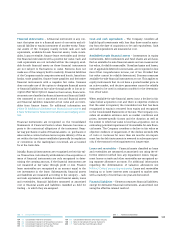Siemens 2011 Annual Report Download - page 264
Download and view the complete annual report
Please find page 264 of the 2011 Siemens annual report below. You can navigate through the pages in the report by either clicking on the pages listed below, or by using the keyword search tool below to find specific information within the annual report.
6 A. To our shareholders 51 C. Combined management’s discussion and analysis 23 B. Corporate Governance
of Financial Position and in the Consolidated Statements of In-
come are translated using the spot exchange rate at the end
of the reporting period. Each non-monetary item on the Con-
solidated Statements of Financial Position which is carried at
cost or amortized cost and each transaction in the Consolidat-
ed Statements of Income are restated by applying a general
price index from the date of acquisition or initial incurrence of
these items. The cumulative effects of inflation are recog-
nized in retained earnings at first time adoption or as gains
and losses in net income at subsequent periods.
Revenue recognition – Under the condition that persuasive
evidence of an arrangement exists revenue is recognized to
the extent that it is probable that the economic benefits will
flow to the Company and the revenue can be reliably mea-
sured, regardless of when the payment is being made. In cas-
es where the inflow of economic benefits is not probable due
to customer related credit risks the revenue recognized is sub-
ject to the amount of payments irrevocably received. Revenue
is measured at the fair value of the consideration received or
receivable net of discounts and rebates and excluding taxes or
duty. The Company assesses its revenue arrangements
against specific criteria in order to determine if it is acting as
principal or agent. The following specific recognition criteria
must also be met before revenue is recognized:
Sale of goods
Revenue from the sale of goods is recognized when the signif-
icant risks and rewards of ownership of the goods have
passed to the buyer, usually on delivery of the goods.
Sales from construction contracts
A construction contract is a contract specifically negotiated
for the construction of an asset or a combination of assets
that are closely interrelated or interdependent in terms of
their design, technology and function or their ultimate pur-
pose or use. When the outcome of a construction contract can
be estimated reliably, revenues from construction-type proj-
ects are generally recognized under the percentage-of-com-
pletion method, based on the percentage of costs to date
compared to the total estimated contract costs, contractual
milestones or performance. An expected loss on the construc-
tion contract is recognized as an expense immediately. When
the outcome of a construction contract cannot be estimated
reliably () revenue is recognized only to the extent contract
costs incurred are probable of being recoverable, and () con-
tract costs are recognized as an expense in the period in
which they are incurred.
When a contract covers a number of assets, the construction
of each asset is treated as a separate construction contract
when () separate proposals have been submitted for each as-
set, () each asset has been subject to separate negotiation
and the contractor and the customer have been able to accept
or reject that part of the contract relating to each asset, and
() the costs and revenues of each asset can be identified. A
group of contracts, whether with a single customer or with
several customers are treated as a single construction con-
tract when () the group of contracts is negotiated as a single
package, () the contracts are so closely interrelated that they
are, in effect, part of a single project with an overall profit
margin, and () the contracts are performed concurrently or
in a continuous sequence.
During project execution variation orders by the customer for
a change in the scope of the work to be performed under the
contract may be received leading to an increase or a decrease
in contract revenue. Examples of such variations are changes
in the specifications or design of the asset and changes in the
duration of the contract.
Rendering of services
Revenues from service transactions are recognized as services
are performed. For long-term service contracts, revenues are
recognized on a straight-line basis over the term of the con-
tract or, if the performance pattern is other than straight-line,
as the services are provided, i.e. generally under the percent-
age-of-completion method.
Sales from multiple element arrangements
Sales of goods and services as well as software arrangements
sometimes involve the provision of multiple elements. In
these cases, the Company determines whether the contract or
arrangement contains more than one unit of accounting. An
arrangement is separated if () the delivered element(s) has
(have) value to the customer on a stand-alone basis, () there
is reliable evidence of the fair value of the undelivered
element(s) and (), if the arrangement includes a general
right of return relative to the delivered element(s), delivery or
performance of the undelivered element(s) is (are) considered
probable and substantially in the control of the Company. If all
three criteria are fulfilled, the appropriate revenue recogni-
tion convention is then applied to each separate unit of ac-
counting. Generally, the total arrangement consideration is
allocated to the separate units of accounting based on their
relative fair values. The hierarchy of fair value evidence is as
follows: (a) sales prices for the component when it is regularly
























